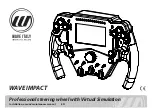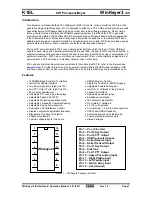
CHAPTER 5: SETTINGS
PRODUCT SETUP
D30 LINE DISTANCE PROTECTION SYSTEM – INSTRUCTION MANUAL
5-113
5
The D30 relay supports one fault report and an associated fault locator per CT bank. The signal source and trigger
condition, as well as the characteristics of the line or feeder, are entered in this menu.
The fault report stores data, in non-volatile memory, pertinent to an event when triggered. The captured data contained in
the FaultReport.txt file includes:
•
Fault report number
•
Name of the relay, programmed by the user
•
Firmware revision of the relay
•
Date and time of trigger
•
Name of trigger (specific operand)
•
Line or feeder ID via the name of a configured signal source
•
Active setting group at the time of trigger
•
Pre-fault current and voltage phasors (two cycles before either a 50DD disturbance associated with fault report
source or the trigger operate). Once a disturbance is detected, pre-fault phasors hold for three seconds waiting for the
fault report trigger. If trigger does not occur within this time, the values are cleared to prepare for the next disturbance.
•
Fault current and voltage phasors (one cycle after the trigger)
•
Elements operated at the time of triggering
•
Events — Nine before trigger and seven after trigger (only available via the relay web page)
•
Fault duration times for each breaker (created by the breaker arcing current feature)
The captured data also includes the fault type, the distance to the fault location, distance to the fault location, fault loop
impedance, as well as the reclose shot number (when applicable). To include fault duration times in the fault report, enable
and configure the breaker arcing current feature for each of the breakers. Fault duration is reported on a per-phase basis.
The relay allows locating faults, including ground faults, from delta-connected VTs. In this case, the missing zero-sequence
voltage is substituted either by the externally provided neutral voltage (broken delta VT) connected to the auxiliary voltage
channel of a VT bank, or by the zero-sequence voltage approximated as a voltage drop developed by the zero-sequence
current, and user-provided zero-sequence equivalent impedance of the system behind the relay.
The trigger can be any FlexLogic operand, but in most applications it is expected to be the same operand, usually a virtual
output, that is used to drive an output relay to trip a breaker. To prevent the overwriting of fault events, do not use the
disturbance detector to trigger a fault report. A FAULT RPT TRIG event is automatically created when the report is triggered.
If a number of protection elements are ORed to create a fault report trigger, the first operation of any element causing the
OR gate output to become high triggers a fault report. However, If other elements operate during the fault and the first
operated element has not been reset (the OR gate output is still high), the fault report is not triggered again. Considering
the reset time of protection elements, there is very little chance that a fault report can be triggered twice in this manner. As
the fault report must capture a usable amount of pre and post-fault data, it cannot be triggered faster than every 20 ms.
Each fault report is stored as a file; the relay capacity is 15 files. A 16th trigger overwrites the oldest file.
The EnerVista software is required to view all captured data. The relay faceplate display can be used to view the date and
time of trigger, the fault type, the distance location of the fault, and the reclose shot number.
The
FAULT REPORT 1 SOURCE
setting selects the source for input currents and voltages and disturbance detection. For the
application of entirely parallel lines, the fault report can be programmed to apply compensation for the zero sequence
mutual coupling between parallel lines when calculating fault resistance and fault loop impedance. If this compensation is
required, the ground current (3I_0) from the parallel line must be connected to the ground input CT of the CT bank
configured under the
FAULT REPORT 1 SOURCE
with the same polarity as the phase current input configured in the same
source.
The
FAULT 1 REPORT TRIG
setting assigns the FlexLogic operand representing the protection element/elements requiring
operational fault location calculations. The distance to fault calculations are initiated by this signal. The
FAULT REPORT 1 Z1
MAG
,
FAULT REPORT 1 Z0 MAG
, and
FAULT REPORT 1 Z0M MAG
impedances are entered in secondary ohms.
For the application of entirely parallel lines, Z0M MAG/ANG is the mutual zero-sequence impedance for the whole line,
required to compensate the calculation of fault resistance and fault loop impedance.
Содержание D30 series
Страница 10: ...x D30 LINE DISTANCE PROTECTION SYSTEM INSTRUCTION MANUAL TABLE OF CONTENTS ...
Страница 14: ...1 4 D30 LINE DISTANCE PROTECTION SYSTEM INSTRUCTION MANUAL FOR FURTHER ASSISTANCE CHAPTER 1 INTRODUCTION 1 ...
Страница 52: ...2 38 D30 LINE DISTANCE PROTECTION SYSTEM INSTRUCTION MANUAL SPECIFICATIONS CHAPTER 2 PRODUCT DESCRIPTION 2 ...
Страница 534: ...5 324 D30 LINE DISTANCE PROTECTION SYSTEM INSTRUCTION MANUAL TESTING CHAPTER 5 SETTINGS 5 ...
Страница 564: ...6 30 D30 LINE DISTANCE PROTECTION SYSTEM INSTRUCTION MANUAL PRODUCT INFORMATION CHAPTER 6 ACTUAL VALUES 6 ...
Страница 578: ...7 14 D30 LINE DISTANCE PROTECTION SYSTEM INSTRUCTION MANUAL TARGETS MENU CHAPTER 7 COMMANDS AND TARGETS 7 ...
Страница 614: ...9 26 D30 LINE DISTANCE PROTECTION SYSTEM INSTRUCTION MANUAL FAULT LOCATOR CHAPTER 9 THEORY OF OPERATION 9 ...
Страница 654: ...A 10 D30 LINE DISTANCE PROTECTION SYSTEM INSTRUCTION MANUAL FLEXANALOG ITEMS APPENDIX A FLEXANALOG OPERANDS A ...
Страница 662: ...C 6 D30 LINE DISTANCE PROTECTION SYSTEM INSTRUCTION MANUAL COMMAND LINE INTERFACE APPENDIX C COMMAND LINE INTERFACE C ...
Страница 670: ...iv D30 LINE DISTANCE PROTECTION SYSTEM INSTRUCTION MANUAL ABBREVIATIONS ...
Страница 686: ...xvi D30 LINE DISTANCE PROTECTION SYSTEM INSTRUCTION MANUAL INDEX ...
















































